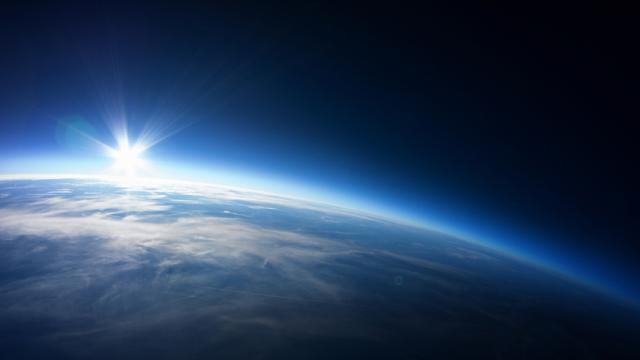Geoengineering — hacking Earth’s climate system to reverse global warming — often sounds a bit preposterous, whether we’re talking about deploying giant space mirrors or dumping a bunch of iron filings into the ocean. The latest proposal? Dusting the stratosphere with billions of dollars worth of powdered diamond.
Yes, you heard that right. It might actually be time to move to Mars.
The new diamonds-in-the-sky geoengineering scheme isn’t the work of crackpots. It comes from a team of respected Harvard scientists, and it was published this week in the peer-reviewed journal Atmospheric Chemistry and Physics. What’s more, it could actually work. It’s actually a variation on another idea geoengineering proponents have tossed around for years — spraying sulfate aerosols into the stratosphere to reflect and scatter the sun’s energy.
It’s Not a New Idea
The idea of cooling the planet with sulfate was inspired by the observation that large volcanic eruptions often have a rapid and dramatic cooling effect on Earth’s climate. Among other things, these eruptions belch tremendous amounts of sulphur dioxide into the stratosphere. Sulphur dioxide spreads around the globe quickly, creating a haze that blocks incoming sunlight. If volcanoes are doing this naturally, can’t we just mimic that process to undo some of the global warming damage we’ve caused?
Maybe, but maybe not. Off the bat, there are a few big problems. First, sulfates react with other chemicals in the stratosphere to produce sulfuric acid, which can damage ozone. And we’d really like to keep our ozone layer — it’s our first line of defence against the most harmful forms of solar radiation. Second, while sulfate aerosols are predicted to scatter incoming sunlight, they could also heat up the lower stratosphere, with untold feedback effects on atmospheric circulation patterns. In short, this idea might work, but it might totally backfire and we won’t know until we try.
Shine Bright Like a Diamond
According to Debra Weisenstein, a co-author on the new study, dusting the stratosphere with solid, nanometre-sized aluminium oxide or diamond particles poses fewer risks than sulfate — for starters, these particles wouldn’t produce nasty sulfuric acid. What’s more, the new study shows that diamond dust would be at least 50% more effective at scattering incoming solar radiation.
But like all geoengineering proposals before it, this latest one is premised on conducting a global experiment on our planet’s climate system, one with potentially far more dramatic consequences than the global climate experiment we’re already in the midst of. And as io9’s George Dvorsky put it, once we start geohacking the planet, we won’t be able to stop.
Writes Nature News:
The scientists warn, however, that both alumina and diamond nanoparticles carry unknown risks. Sulphates are reasonably well understood, thanks to research on volcanoes. By contrast, the chemistry of the solid particles — such as how their surfaces catalyse chemical reactions — is not as clear, although the Harvard researchers are doing lab tests to remedy that.
There’s an Easier Fix
Here’s another idea: Why don’t we put the billions of dollars it would take to fill the stratosphere with diamond toward developing renewable energy sources and weaning ourselves off fossil fuels? That’s arguably a much safer course of action, and progress toward the goal of a low-carbon future is already well underway.
According to a report by the International Energy Agency, renewable energy sources accounted for nearly half of all new power generation capacity in 2014. China, the world’s largest carbon emitter, has been leading the way, increasing its solar energy capacity by a full 18 gigawatts this year. Every year, the cost of wind and solar energy is falling. And while we’re not yet moving fast enough to avoid dangerous climate change, there’s still hope that world leaders will hash out much tougher carbon pollution resolutions at the global climate conference in Paris this December.
Or, you know, we could pump a bunch of diamond powder into the sky and see what happens. Hey, we’re nothing if not adventurous when it comes to planetary tinkering.
Top image: Shutterstock
